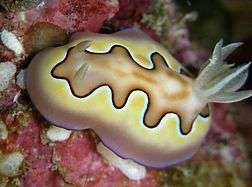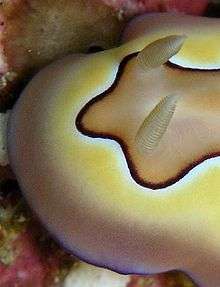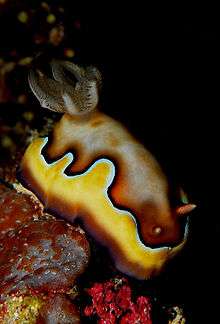Goniobranchus coi
| Goniobranchus coi | |
|---|---|
 | |
| Goniobranchus coi | |
| Scientific classification | |
| Kingdom: | Animalia |
| Phylum: | Mollusca |
| Class: | Gastropoda |
| (unranked): | clade Heterobranchia clade Euthyneura clade Nudipleura clade Nudibranchia |
| Superfamily: | Doridoidea |
| Family: | Chromodorididae |
| Genus: | Goniobranchus |
| Species: | G. coi |
| Binomial name | |
| Goniobranchus coi (Risbec, 1956)[1] | |
| Synonyms[2] | |
| |
Goniobranchus coi is a species of very colourful sea slug, a dorid nudibranch, a marine gastropod mollusc in the family Chromodorididae.[2]
Distribution
This species was described from Vietnam. It occurs in the tropical Western Pacific Ocean from Australia to the Philippines.[3]
Description
Goniobranchus coi has a white body and foot, but is instantly recognizable by its distinct dorsal pattern. The outer part of the mantle is yellow, separated from the inner light-brown part by a wavy white and black line. The outer edge of the mantle is brown, with a thin purple line at the margin. The gills and rhinophores range in colour between different individuals from translucent white, through pale-yellow and light-brown. This species reaches at least 50 mm in length.[4]
 A close up of the rhinophores of G. coi
A close up of the rhinophores of G. coi Goniobranchus coi
Goniobranchus coi
Ecology
Like most sea slugs in the superfamily Doridoidea, Goniobranchus coi feeds on sponges. It has been seen feeding on the sponge Chelonaplysilla violacea.[5]
References
- ↑ Risbec, J. 1956. Nudibranches du Viet-Nam. Archives du Museum National d'Histoire Naturelle Paris, series 7, 4:1-34, pls. 1-22.
- 1 2 Bouchet, P. (2012). Goniobranchus coi. Accessed through: World Register of Marine Species on 2012-05-01
- ↑ Rudman, W.B., 1999 (October 17) Chromodoris coi (Risbec, 1956). [In] Sea Slug Forum. Australian Museum, Sydney.
- ↑ Rudman W.B. (1987) The Chromodorididae (Opisthobranchia: Mollusca) of the Indo-West Pacific: Chromodoris epicuria, C. aureopurpurea, C. annulata, C. coi and Risbecia tryoni colour groups. Zoological Journal of the Linnean Society 90: 305-407. page(s): 395
- ↑ Lau, A, 2005 (Dec 15) Chromodoris coi & sponges. [Message in] Sea Slug Forum. Australian Museum, Sydney.
Further reading
- Debelius, H. & Kuiter, R.H. (2007) Nudibranchs of the world. ConchBooks, Frankfurt, 360 pp. ISBN 978-3-939767-06-0 page(s): 143
- Gosliner, T.M., Behrens, D.W. & Valdés, Á. (2008) Indo-Pacific Nudibranchs and seaslugs. A field guide to the world's most diverse fauna. Sea Challengers Natural History Books, Washington, 426 pp. page(s): 215
- McDonald G. (2009) Nudibranch Systematic Index. 2nd online edition. 724 pp
- Johnson R.F. & Gosliner T.M. (2012) Traditional taxonomic groupings mask evolutionary history: A molecular phylogeny and new classification of the chromodorid nudibranchs. PLoS ONE 7(4): e33479